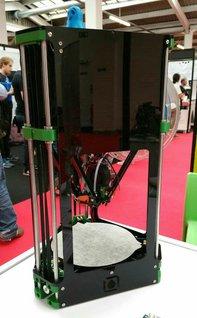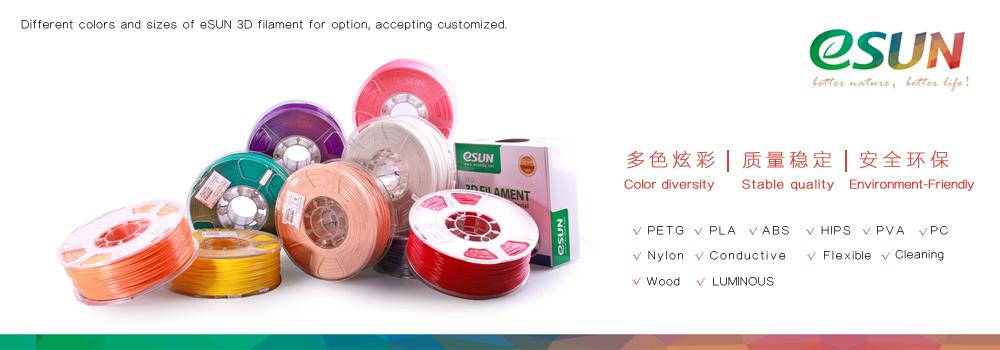 Reading, writing, arithmetic, and RepRap 3D printing. These will be the new and revised fundamentals of learning for a number of lucky kids in Asia soon. While the world of manufacturing is being revolutionized by 3D printing, so are many of the educational practices and tools for children in science and technology as digital design and 3D printing enter the scene and take hold of the younger generation’s interest.
Reading, writing, arithmetic, and RepRap 3D printing. These will be the new and revised fundamentals of learning for a number of lucky kids in Asia soon. While the world of manufacturing is being revolutionized by 3D printing, so are many of the educational practices and tools for children in science and technology as digital design and 3D printing enter the scene and take hold of the younger generation’s interest.
 In a partnership just forged between eSUN, a filament company headquartered in Shenzhen, China, and RepRap, the two are creating an open source 3D printing ‘kit’ for kids in Asia, and it comes just in time for the 3rd Chengdu World 3D Printing Technology Expo. This is an industry conference which gives attendees the chance to explore the future of 3D printing and its role in business, as well as how to integrate it with traditional manufacturing. Sponsored by the World 3D Printing Technology Industry Alliance and Asian Manufacturing Association, it will be held in Chengdu from June 3-6, where the new 3D printer and project will be unveiled.
In a partnership just forged between eSUN, a filament company headquartered in Shenzhen, China, and RepRap, the two are creating an open source 3D printing ‘kit’ for kids in Asia, and it comes just in time for the 3rd Chengdu World 3D Printing Technology Expo. This is an industry conference which gives attendees the chance to explore the future of 3D printing and its role in business, as well as how to integrate it with traditional manufacturing. Sponsored by the World 3D Printing Technology Industry Alliance and Asian Manufacturing Association, it will be held in Chengdu from June 3-6, where the new 3D printer and project will be unveiled.
eSUN and RepRap will be offering a different type of 3D printing experience, as it is customized and geared completely toward kids, even featuring lower internal and surface temperatures for safety. With this project in mind, priorities were placed on safety first, as well as an attractive price point and eco-friendliness. Dubbed the ‘Low Temperature 3D Printing Kit for Children,’ it will offer a secure way to grab the interest of students in science and technology classes.
The kids won’t be working with temperatures over 100 degrees in any case, as the nozzle is set at a limit of just that, and surface temperatures can’t exceed 70 degrees, cutting the heat factor by more than half. The kit presents an easy and simple way to get involved in 3D printing, without faculty having to worry about liability issues, as well as offering technology geared toward a younger age and aptitude, taking away the one-size-fits-all ideal which perhaps is not always a perfect fit for elementary school age kids.
Kids will also have the chance to use eSUN’s 4d-fila innovative filament which is unique in that it is composed of PCL, a biodegradable polyester (polycaprolactone) that features a low melting point and allows the user to repair it even after printing. The filament is part of a line-up of materials from eSUN, which demonstrates their dedication to environmentally friendly products, as they continue researching and developing further in the bioengineering field.

Asian businesses involved in the 3D printing industry have a strong interest in the educational sector with the desktop scene, and this new kit may represent a growing trend to set a younger age range on some equipment for learning levels and safety purposes. In a country where the goal is to make 3D printing accessible to every child, the kit shows a dedication to that purpose, set up by RepRap founder Dr Adrian Bowyer and Yihu Yang, CEO of eSUN.
Do you think it’s important for children to gain access to 3D printing at the elementary and secondary school levels? Discuss your thoughts in the Low Temperature 3D Printing Kit forum over at 3DPB.com.

Subscribe to Our Email Newsletter
Stay up-to-date on all the latest news from the 3D printing industry and receive information and offers from third party vendors.
You May Also Like
Gorilla Sports GE’s First 3D Printed Titanium Cast
How do you help a gorilla with a broken arm? Sounds like the start of a bad joke a zookeeper might tell, but it’s an actual dilemma recently faced by...
Nylon 3D Printed Parts Made More Functional with Coatings & Colors
Parts 3D printed from polyamide (PA, Nylon) 12 using powder bed fusion (PBF) are a mainstay in the additive manufacturing (AM) industry. While post-finishing processes have improved the porosity of...
$25M to Back Sintavia’s Largest Expansion of Metal 3D Printing Capacity Since 2019
Sintavia, the digital manufacturing company specializing in mission-critical parts for strategic sectors, announced a $25 million investment to increase its production capacity, the largest expansion to its operations since 2019....
Velo3D Initiates Public Offering in a Bid to Strengthen Financial Foundations and Drive Future Growth
Velo3D (NYSE: VLD) has been among a number of publicly traded 3D printing firms that have attempted to weather the current macroeconomic climate. After posting a challenging financial report for 2023,...































